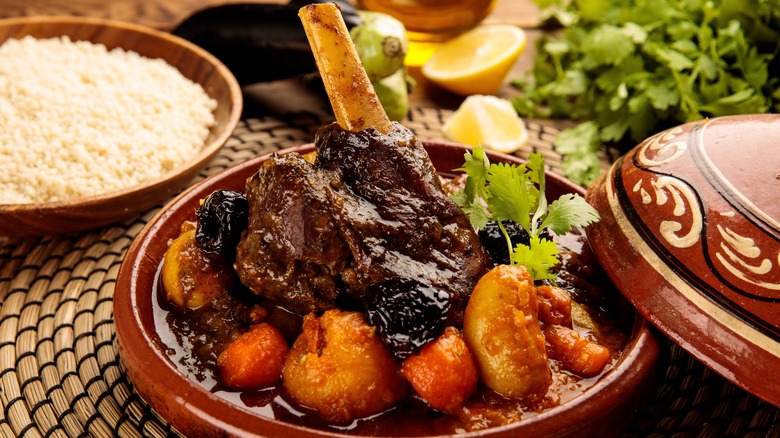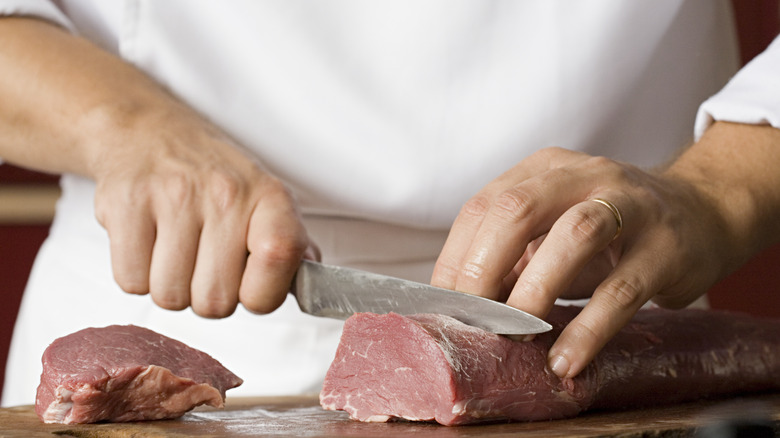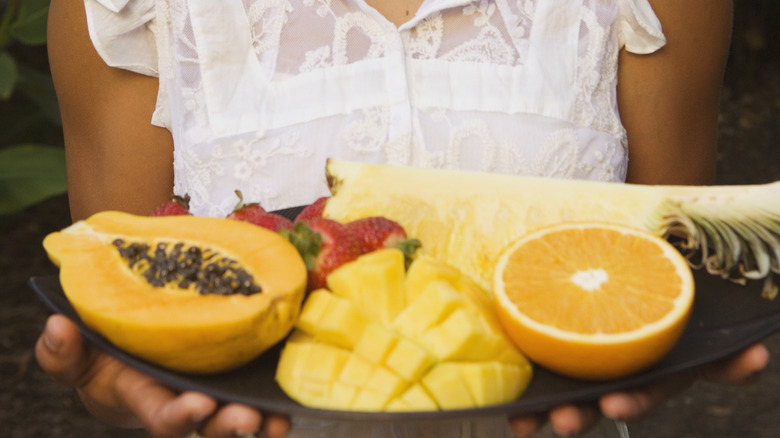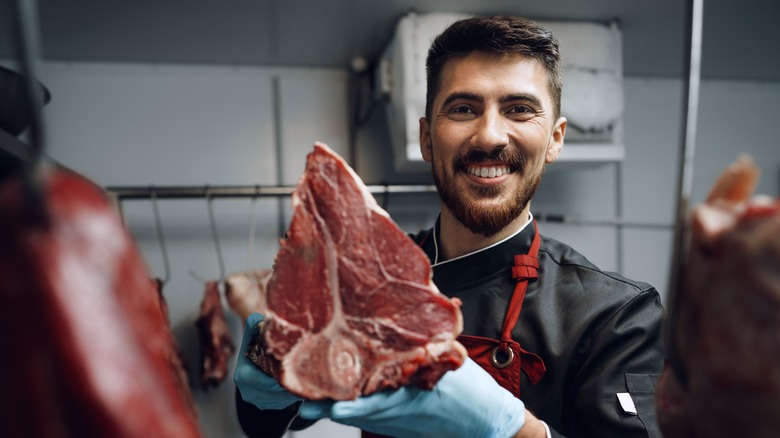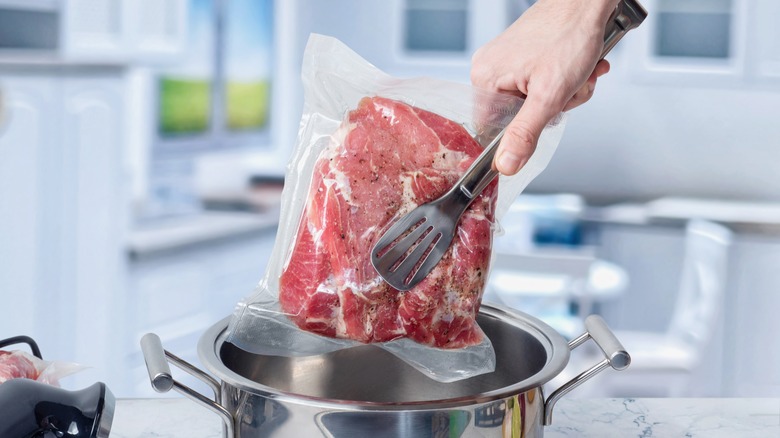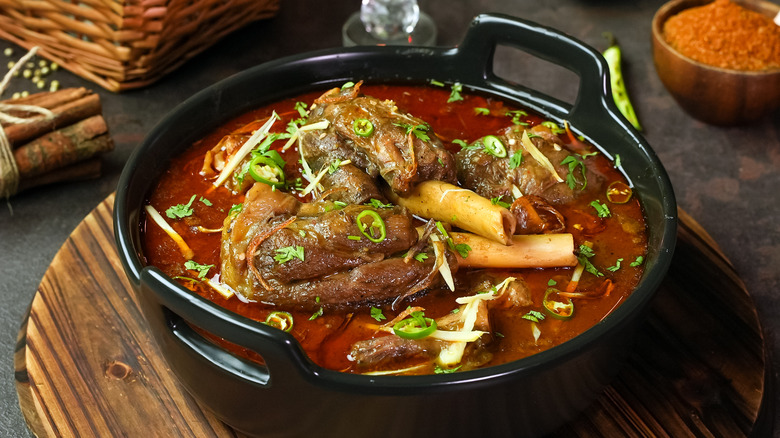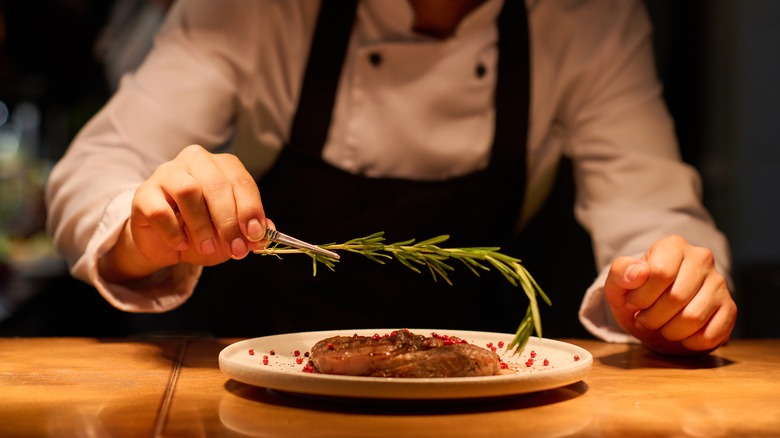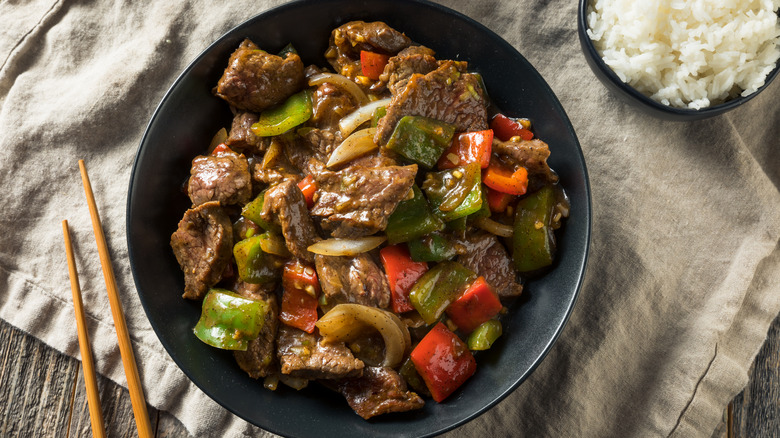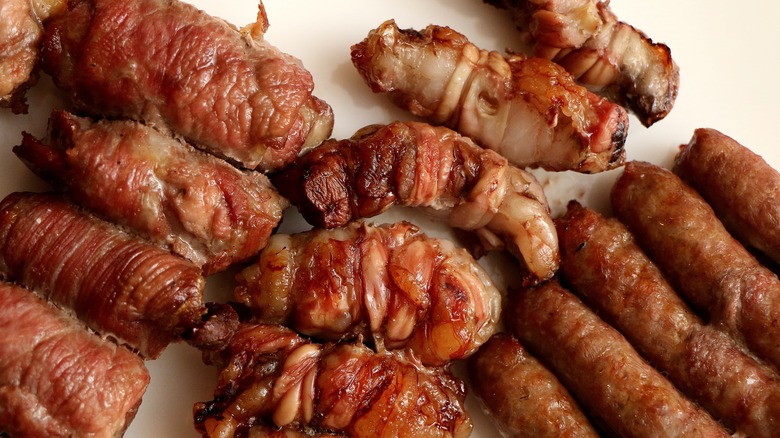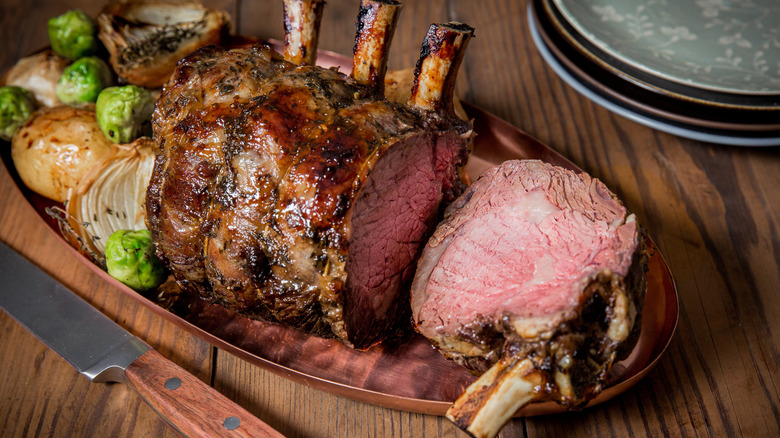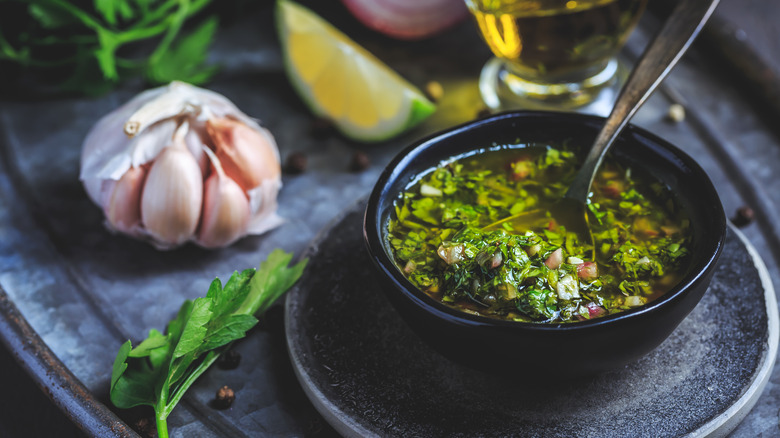10 Expert-Approved Ways To Upgrade Your Lamb Dish
Where's the lamb? Everywhere it seems, except on dinner plates in the USA. Americans typically include plenty of meat in their diets, going through a whopping 280 pounds per capita in 2021, according to the Food and Agriculture Organization of the United Nations. Tied with Australia as a top meat-consuming country, American grocery stores usually offer cheap and easy access to beef, chicken, and pork. Yet of all that meat consumed, only a pound comes from lamb.
Conversely, Aussies consider roast lamb their national dish. Lamb and mutton are widely eaten outside the U.S., forming a major part of cuisines ranging from Levantine and South African to Icelandic and Mongolian. Theories abound regarding the disappearance of lamb from American tables. For starters, it never had marketing campaigns like beef or pork. Lamb was a staple during World War II, so in the celebratory post-war era, people leaned toward beef. Once lamb fell out of fashion, it became expensive and hard to find, and nowadays, many Americans simply don't know how to work with it.
Could the silence of the lambs be over? Lamb is more efficient to raise than beef, making it a sustainable choice. It's not factory-farmed, and the price point is comparable to grass-fed beef. Americans are also gaining cultural exposure to lamb from different cuisines. To that end, we've put together an expert-approved cheat sheet to guide you toward great results.
1. Know your ratios
There's no need to be intimidated by a trip to the butcher if you've done your math homework. Lamb isn't as marbled with fat as beef, so your end product is more likely to be dry if you aren't working with the optimal ratio of meat to fat. For this reason, Damian D'Souza, professional cook and writer, chooses lamb mince with a higher fat content than you might prefer for beef — about 20 to 30% by weight. When you're making meatballs and burgers, the extra fat keeps them moist and juicy. Lamb mince is relatively affordable and an accessible way to introduce lamb into your diet, so don't ruin it by going too lean.
Knowing the amount of fat in common cuts of lamb gives you a clue as to how to cook them. Shoulder cuts are fattier with more meat on the bone. Like hardworking shanks, they're great for long, slow cooking. A rack of lamb is very tender, though not as meaty. It makes for an impressive roast, while chops can be briefly seared or grilled. Filets and loin cuts are great for quick cooking, and ideal for stir-fries or tender medium-cooked roasts. The leg is the leanest cut and packed with plenty of meat. "I sometimes ask the butcher for some extra fat to cook with the leg," says Jehan Hilloowala, co-founder of Smoke by the Sea cloud kitchen in Mumbai. Conversely, you can ask your butcher to trim excess fat from your lamb.
2. Use a natural meat tenderizer
Unlike cattle, lamb in the U.S. is primarily raised on pastures. As a result, the meat is more flavorful but less uniformly tender than beef. The fat content and quality of lamb will also vary depending on your access to a butcher or what's available at your grocery store. Lean cuts like leg of lamb will especially benefit from a marinade, so let the meat sit with ingredients that act as natural tenderizers.
Acidic foods like lemon juice, wine, and vinegar help break down tough proteins, and yogurt is used around the world as a marinade for lamb, particularly before grilling. It adds moisture and fat to the meat, as well as lactic acid. You can also use fruit-based meat tenderizers like pineapple, kiwi, fig, or mango. Raw papaya doesn't add any flavor, so it works with many marinades. These fruits contain enzymes called proteases that break down protein chains. Many are acidic too, so the enzymes and acids act together to tenderize meat. Use fruit juices as a liquid component in your marinade, or puree whole fruit and blend it with herbs and spices.
When using natural tenderizers, be careful not to marinate for more than a couple of hours, as the meat will eventually turn mushy and unpleasant. For larger cuts of lamb, marinating overnight is okay; score the meat so the marinade can penetrate all the way through.
3. Choose the right cut for the right purpose
If you're familiar with beef cuts, you should know that lamb cuts don't translate to the same recipes. Beef steaks are usually cut from the torso of the cow, which produces a wide range of cuts that can be quickly seared. Lamb is a much smaller animal, and torso cuts include ribs and roasting meats. Lamb steaks come from the rump and back legs and are ideal for quick cooking. A beef tenderloin makes a hearty roast dinner for the family, but a lamb tenderloin is a portion for one.
Aside from the cut, it's important to choose lamb from specific sources depending on what you're making. American lamb is milder and fattier, while imports from Australia and New Zealand are leaner and have more flavor. Although all three types of lamb are excellent options for impressive roasts and racks, the imported varieties are better for curries and braises. Meanwhile, mutton, which comes from adult sheep, has a stronger flavor and is harder to find. Learn more about the difference between lamb and mutton.
Your best bet for finding different cuts and varieties of lamb is to ask a butcher. In Caribbean, South Asian, and halal grocers, goat meat is often referred to as lamb or mutton, so double-check what you're getting. Goat is much leaner than lamb, so while it can be a good substitute in curries, stews, kebabs, and pilafs, it's more likely to dry out in a hot oven.
4. Try cooking sous vide
As lamb is inherently a fattier meat and more prone to toughness than beef, cooking it in a sous vide ensures that it melts in the mouth. The low temperature and slow process allow the meat to cook evenly by heating and holding water at an exact temperature. Food is vacuum-sealed inside a plastic bag and placed in the water bath until cooked through. Because the heat is so precise and doesn't change, food doesn't overcook. Unlike cooking over dry heat, it remains moist and cooks very evenly. If your food isn't quite ready, you can reseal it and stick it back in the water bath, maintaining the temperature throughout.
Hilloowala recommends cooking lamb in a sous vide first, then searing or roasting it over high heat to create a nice crust. His workaround for a sous vide setup without buying a special appliance is straightforward; all you need is a thick Grams per Square Meter (GSM) polypropylene bag that is heat-safe and won't melt. Use a straw to suck out as much air from the bag as possible to create a vacuum, then seal the lamb inside. Submerge it completely in a pressure cooker or Dutch oven with weights. Place it over low heat and use a digital thermometer to keep the temperature around 160 F.
5. Go for bold spices and seasonings
Along with fresh herbs that cut through the richness, the earthy taste of lamb also pairs well with strong spices. The bitter notes of cumin are a perfect foil, so it's no wonder the spice is ubiquitous in lamb dishes. Consider a homemade take on spicy lamb noodles loaded with cumin and Sichuan peppercorn. Lamb plays nicely with coriander too, which is the seed of the cilantro plant. The green leaves add a fresh aroma to a finished dish, while the seed is best added at the start of cooking to bring a citrusy warmth.
For leg of lamb, Hilloowala likes to combine coriander with red chili powder and smoked paprika. Whether you're marinating the meat with a fruity tenderizer like pineapple or just doing a dry rub, this pairing is a winner. Mint, rosemary, and bay are a classic trinity, while fresh seasonings like oregano, fennel, or saffron bring a complex aroma to the dish. Try adding a splash of red wine to bring out the flavor of slow-cooked or braised lamb, cutting through the richness of the meat and dialing up the umami.
Add a warm baharat blend with spices like cumin, cloves, cinnamon, and cardamom to a lamb burger for a Middle Eastern twist or a generous dry rub of garam masala and smoked paprika to a roast. You could also play with the gaminess of lamb by adding chunks of blue cheese to your burgers.
6. Don't overdo the seasoning
A common mistake that home cooks make when marinating or seasoning lamb is to add salt too early. "Salt will draw the moisture out of the meat," says D'Souza. Instead, prepare your marinade without salt, then season your meat right before cooking. The same applies to meatballs, kebabs, and mince that's going into a filling. For burgers, season once you flip; try this tip when you're making these delicious Greek-style lamb burgers that feature fresh, herbal flavors of spring.
Another challenge when cooking with lamb is determining the quantity of seasoning to use. Because lamb is often seen as having a strong or gamey taste, you might be tempted to season heavily. Lamb can hold up to strong seasonings, but they should complement the meat, not overwhelm it. "It's best to lean into the grassy flavor and work with it," explains D'Souza. For instance, Mediterranean recipes make ample use of garlic, which is lamb's best friend. They may include punchy ingredients like capers, olives, and anchovies that preclude the need for any additional spices. Since these ingredients are already salty, put them on the lamb right before cooking and be conservative when adding more salt.
7. Experiment with new cuisines
"Don't be afraid to build a skill set with lamb," urges Hilloowala. Since lamb can be expensive, the last thing you want is to splurge on a pricey piece of meat and then risk ruining it. But there are plenty of tried-and-tested recipes that put less desirable cuts of lamb to good use. While you save up for that showstopping crown roast, get started with cheaper, tastier cuts.
Lamb necks and bones are great in a stew or braise, providing plenty of meat and collagen. They're relatively affordable, and stews are a canvas to experiment with seasonings and spices — though you could take a minimalist approach with this Irish stew. Since stews are slow-cooked until the lamb is tender, they're hard to mess up.
Lamb breast, with its unctuous texture, is best slow-roasted to develop a crispy crust and paired with something tart, like gremolata. Lamb shoulder is another cheap cut that benefits from slow cooking, as in this Instant Pot recipe. Experiment by rubbing the shoulder with jerk seasoning, five-spice powder, or ras el hanout before adding it to the onion base.
D'Souza suggests getting a feel for lamb by starting with Asian dishes that require quick cooking. Think stir-fries, hotpots, or noodle soups, before moving on to complicated dishes like biryani. Once you get the hang of cooking with lamb, you can graduate to expensive cuts like saddles and chops. Before you begin, check out these common mistakes when cooking with lamb.
8. Don't overlook offal
If vintage menus are to be believed, kidneys were once so widely eaten in the U.S. that they were a staple offering at the breakfast table. While we don't necessarily advocate serving stewed kidneys alongside your morning coffee, there is a growing culinary movement to bring back nose-to-tail eating. It's a more sustainable way of eating meat that makes the most of every part of an animal.
Plus, there are health benefits to eating more than muscle meat. Organ meats are highly nutritious and rich in essential vitamins, minerals, and nutrients like choline that can be hard to find from other food sources. Experts will tell you the real reason to acquire a taste for offal is that they can be the most delicious cuts when prepared properly. Americans might have lost their love for offal, but it remains popular around the world.
Lamb kidneys are a classic, prized for their rich texture. D'Souza recommends using lamb hearts for kebabs and yakitori-style skewers. Naturally bite-sized, hearts don't have the strong taste of liver, and a quick grill yields a charred, meaty morsel that resembles steak. A braise is the way to go for lamb tongues, which are very lean and tender. Like hearts, tongues taste similar to more common cuts, and when sliced thinly make for a perfect sandwich filler. "Lastly, don't sleep on lamb trotters," advises D'Souza. "They are good eating, plus they make full-bodied stocks that elevate any dish."
9. Make sure not to overcook it
As with any other meat, there's a big difference between properly cooked and dry lamb. If you've never really enjoyed lamb, you may have only had tough chops and overdone roasts. Many quick-cooking cuts of lamb are best cooked to medium or even medium-rare, retaining a light pink interior.
A digital thermometer makes it easy to tell when lamb is done. Medium-rare is an internal temperature of 145 degrees Fahrenheit, while medium is 160 and well done is 170. Measure into the thickest part of the meat, and remove it from the heat when it's 10 degrees under your desired temperature, as there will be carry-over cooking. If you don't have a thermometer, try this thumb test instead.
Tougher cuts are best cooked low and slow. "See what texture you like," suggests Hilloowala. Some people like soft lamb that falls off the bone, while others prefer a little bite and chew. Still, lamb shouldn't be very tough. When braising or stewing for a long time, the fibers of the meat will eventually dry out and toughen. A slow cooker will help avoid this, as the temperature remains low and steady. A pressure cooker or Instant Pot is another secret weapon to transform cheaper braising cuts into a stew or curry. If you don't have the luxury of waiting a few hours, your recipe time will be reduced since the pressurized environment breaks down cuts of lamb in record time.
10. Pair it with the right sauces and condiments
It's one thing to cook a delicious lamb dish and another to serve it in a way that does justice to your work. A good selection of sauces and condiments will elevate your lamb and simplify your meal planning. You can prepare lamb once and eat it throughout the week, changing up the sauces so you never get bored. The simplest iteration is to gently cook a lamb shank in a pot with plenty of salt and good olive oil for three hours until the meat goes brown and sticky. Serve it with garlicky tzatziki and pita, and if you manage to save some leftovers, use them as a topping for hummus with an extra drizzle of tahini on top.
Up your barbecue game with lamb asado from Francis Mallman's "Seven Fires: Grilling the Argentine Way." This expert-approved recipe involves grilling an entire lamb over an open fire, but if you're feeling less adventurous, you can substitute smaller cuts like chops and skewers. The main attraction is the smoky, chargrilled flavor and the piquant chimichurri verde on the side.
The sharp, parsley-based sauce makes a great dip for thinly sliced lamb's tongue. Any leftover asado is divine served with toum and shawarma pickles. As well as tangy sauces, lamb lends itself well to sweet pairings. The British combination of roast lamb with sweet-and-sour mint jelly is a classic for a reason. Similarly, try sauces and gravies flavored with dried plums or cinnamon.
